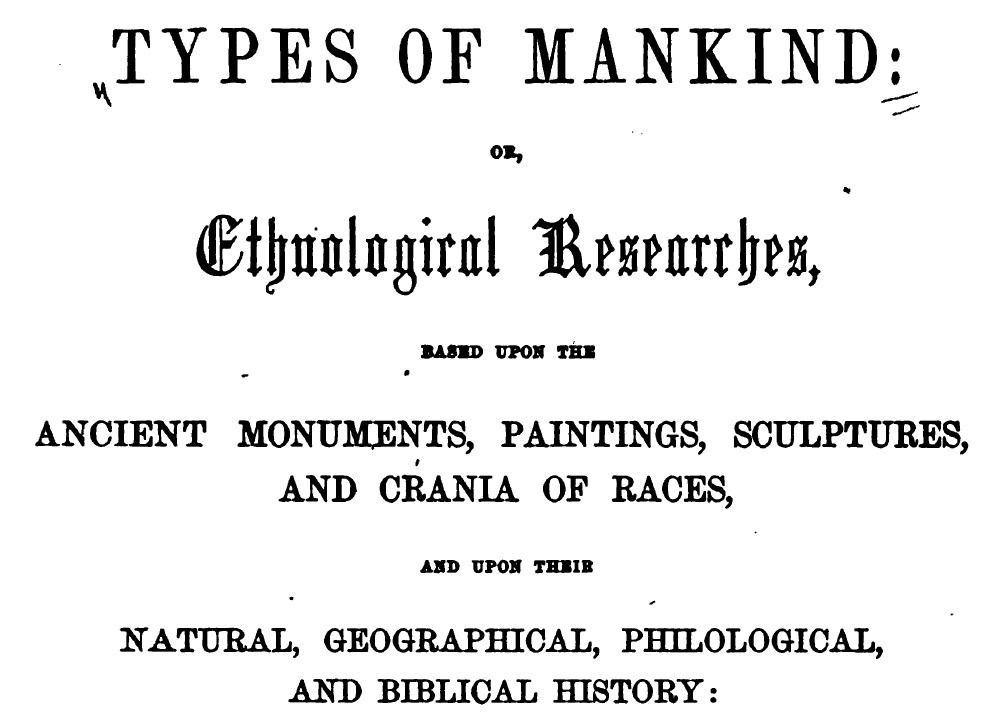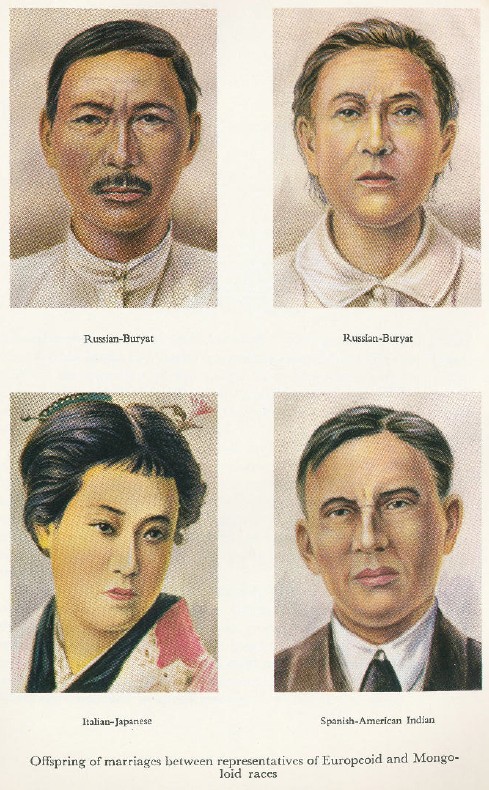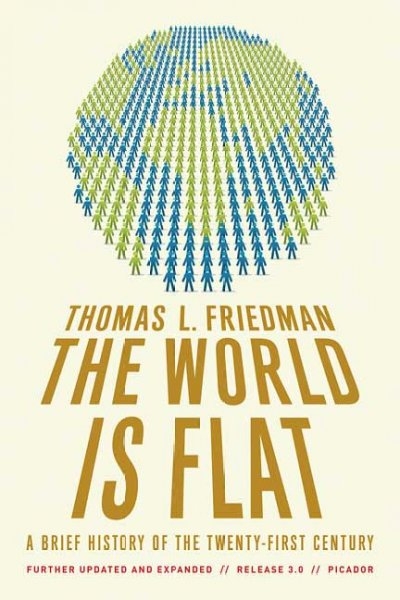In looking at all of the racialized/essentialist/Orientalist concepts that Trần Ngọc Thêm employs in his textbook, Searching for the True Nature of Vietnamese Culture (Tìm về bản sắc văn hóa Việt Nam), in order to promote the idea of Việt supremacy, I started to wonder how far back in time we would have to go in order to find a work like this in “the West.”
While there were certainly many racialized/racist ideas that were expressed in writing during the first half of the twentieth century when much of the world was under the colonial rule of Euro-American nations, Trần Ngọc Thêm’s combined use of concepts from yin yang theory in the Yijing, to racialized explanations of culture, to ideas of environmental determinism, lead to think that we might have to go all of the way back to 1854 to a work like Types of Mankind to find a work that is comparable to Searching for the True Nature of Vietnamese Culture.
In that work, Josiah Clark Nott and George R. Gliddon built on the racial theories of Samuel George Morton to argue that human beings were so racially distinct from each other that they must have developed from multiple lineages.
In making this argument, and as the cover of the book indicates, Nott and Gliddon, like Trần Ngọc Thêm, made use of a similarly diverse range of source materials (race/geography/the Bible vs. race/environment/the Yijing) to make similarly essentialist conclusions.

While I was looking for a book that we could compare to Searching for the True Nature of Vietnamese Culture, in addition to Types of Mankind, I came across another interesting work, a book called Races of Mankind.
This book was written by Soviet anthropologist Mikhail Fedorovich Nesturkh and was published in English in 1963.
In it, Nesturkh presents a non-essentialist explanation of race. To quote, he states that “Soviet anthropology proceeds from the concept of races as biological subdivisions of mankind that have taken shape in the course of a lengthy and intricate evolution.” (8)
He goes on to say that “Races and racial differences are not something eternal, immutable and inherent in man.” (9)
In fact, to Nesturkh and other Soviet scholars, none of the categories that we use to organize human beings – race, nation, ethnicity – were eternal, immutable or inherent in mankind and he quotes Marx and Engels as saying that they “can and must be eliminated by historical development.” (9)

Nesturkh’s book contains a preface by Nikolai Nikolaevich Cheboksarov, the Soviet scholar whose ideas about race we saw Trần Ngọc Thêm distort in the first post of this series.
Writing in 1963, Cheboksarov noted the importance of Nesturkh’s challenge to the racist idea that there were different types of people who were eternally part of some inherent category of human being. To quote, he wrote the following:
“A correct conception of the races of mankind is of particularly great political and scientific importance today, in the period of the collapse of the colonial system and the unparalleled development of the struggle for national liberation by the dependent and colonial peoples. The ideologists of imperialism, in their effort to provide a basis for class, national and colonial oppression, have advanced the false ‘theory’ of the physical and mental inequality of races, of the existence of ‘higher’ and ‘lower’ races, of races that are capable and those that are incapable of independent social, economic and cultural development.” (5)

In other words, Cheboksarov believed that the colonized, and people in newly-independent countries, needed to free themselves from the idea that there were inherent differences between peoples so that they could transform themselves and their societies for the better.
At the same time, however, Cheboksarov realized that this would be very difficult, for as he noted, “Racism is closely bound up with reactionary nationalism and chauvinism” and that “nationalist prejudice and the survivals of former national discord constitute the sphere in which resistance to social progress may be the longest, fiercest, most stubborn, and most implacable.” (5-6)

If we cold bring Nikolai Nikolaevich Cheboksarov back to life and get him to read Trần Ngọc Thêm’s Searching for the True Nature of Vietnamese Culture, I am certain that he would shake his head and sigh at how stubbornly the author sticks to nationalism and chauvinism.
At the same time, if we could bring Josiah Clark Nott and George R. Gliddon back to life and get them to read Trần Ngọc Thêm’s book, while I’m certain that they would completely disagree with his argument for Việt supremacy, I don’t think that they would have any difficulty in understanding his use of racialized and essentialist binary categories, as well as his use of an ancient text to “prove” the existence of those categories in certain human populations.

So here we are in the twenty-first century, the age of globalization when Vietnam has “integrated” (hội nhập) into the world, and the official textbook at the university level in Vietnam for teaching students about their own society reads like a book that a nineteenth-century racist American could have written. . .
Sorry Thomas Friedman, but the world is not flat. In fact, it is nowhere close to being flat, as there are mountains that divide some countries from other, less reactionary parts of the world.


This Post Has 4 Comments
Bản sắc (from the book’s title) is magic words that started to gain currency in the 1980s in Vietnamese cultural politics. The Nghị quyết 05 về Văn hoá Văn nghệ ngày of 1987. This government decision directs:
Chú trọng phát huy bản sắc của nền văn hóa dân tộc và xây dựng bản lĩnh của con người mới Việt Nam để có thể tiếp thu những yếu tố văn hóa tốt đẹp từ bên ngoài vào và chủ động, vững vàng trước mọi thử thách [Attach importance to bringing into play the character of national culture and build the aptitude of new Vietnamese people so that they can acquire the finest cultural principals from outside and take the initiative and be steady in the face of all trials.]
I think it’s used as a continuing attempt to reform thought (cải tạo tư tưởng) in Vietnam. Nationalist culture is used to mold people who will be receptive to the state and its initiative. Trần Ngọc Thêm’s work is just one component of that greater plan. It’s part of the greater propaganda apparatus.
Is bản sắc a term used in Chinese and Korea?
You’re right on the money here!!
I wrote about bản sắc a long time ago.
https://leminhkhai.wordpress.com/2010/06/22/linguistic-incommensurability-and-vietnamese-national-identity/
https://leminhkhaiviet.wordpress.com/2013/04/18/ban-sac-va-identity/
It exists in Chinese, but it’s not used in the same way as it is used in Vietnamese today (I’m not sure about Korean). There it means what it literally means – “basic color” = “true characteristics” or “basic nature.” It’s meant to describe something that cam be objectively determined. Now in Vietnam, however, it is used to mean what people think is an equivalent of “identity,” but identity is subjectively constructed (and people have multiple identities), rather than something that can be objectively determined (which is what Tran Ngoc Them tries to do).
But this all fits perfectly with what you say. And it also fits the timing that you mention above.
And yes, if you look at how the agricultural/static/am culture is described, it is very easy to see social engineering going on: they like to be safe and secure, they don’t cause trouble, they are compromising, flexible, etc.
Thank you very much for this 5-part series that expose Trần Ngọc Thêm’s “nonsense scholarship”. I’ve been deeply troubled by his scholarship but never have enough academic knowledge in this field to take him down. Vietnam needs to see more “investigative academics” (I can’t think of an appropriate phrase for this) of this kind. There are still so many “quack doctors” selling and spreading their “snake oil” knowledge in VN’s universities that it pains me to think about how many young people’s minds have been and are being poisoned by them. This series should be made known widely. I wonder if anyone has tried to translate them into Vietnamese yet? Please keep up the effort, Prof. Le!
Thank you very much for your kind comment!!
I have no control (nor have I ever had any control) over what gets translated from this blog. I do find it interesting, however, that no one has translated this series. I also suspect that no one will translate the recent Bình Ngô đại cáo series that I wrote.
The Vietnamese cyberspace/blogosphere is filled with “debates/discussions,” however, all of those “debates/discussions” remain at a superficial level. And there is a reason for that. It enables life to go on, and no one has to take responsibility for their ideas.
My sense is that the series on Trần Ngọc Thêm and the Bình Ngô đại cáo is too powerful for Vietnamese to handle, because it doesn’t allow life to go on. Those series demand that scholars take responsibility for their ideas, and that is something that no one in Vietnam is willing to do.
Ultimately both of those series humiliate the world of Vietnamese scholarship for having produced rubbish for decades. And because Vietnamese scholars have produced rubbish for decades, they do not have the ability to “argue back” to the evidence that those two series present. Therefore, their best option is just to “ignore” what I wrote there.
I am totally sympathetic with you. I also agree that Vietnamese have been “poisoned” with “nonsense scholarship,” and I don’t think it is right that 100 million people on the planet today should have no other option but to learn from “quack doctors.” But ultimately that’s not my responsibility. So I enjoy being an “investigative academic” (great term!!), but I leave it to others to decide whether or not they want to act on those investigations. 🙂